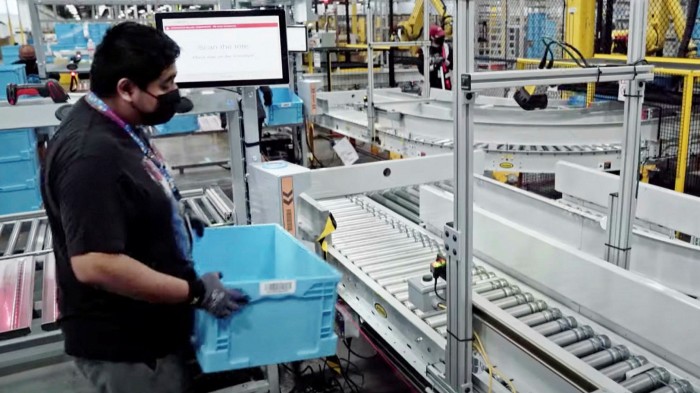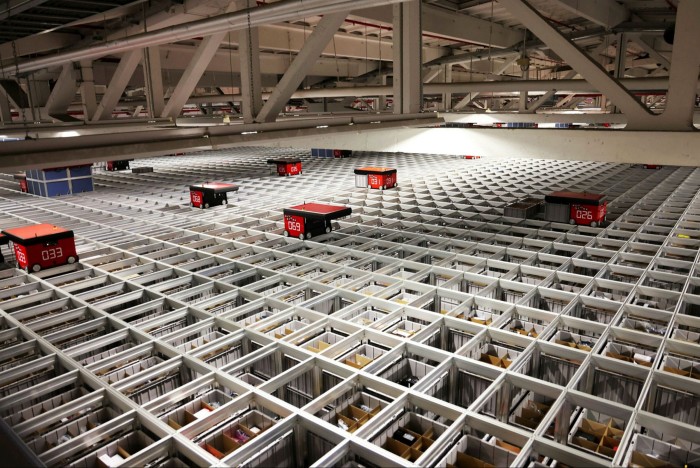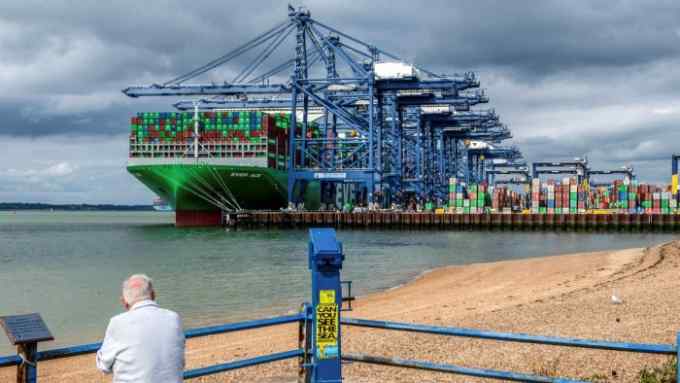Robotics supply helping hand to speedy order fulfilment

Roula Khalaf, Editor of the FT, selects her favourite stories in this weekly newsletter.
Amazon warehouse workers may soon have new recruits among their ranks: “Bert” and “Ernie”.
Named after the pair of muppets in US educational TV series Sesame Street, Ernie is a system with a robotic arm that delivers containers to staff, reducing strenuous reaching and bending, while Bert is an autonomous mobile robot that can be summoned to carry items.
They underline how the US retail and logistics colossus has taken a head-and-shoulders lead in warehouse automation — a market that is set to almost double by 2025 to $68bn, according to consultancy Interact Analysis.
Analysts say chronic labour shortages and the complexity of ecommerce have accelerated the uptake of automation since the onset of the pandemic, transforming a cost-saving exercise into a critical issue for competitiveness.
Tom Bianculli, chief technology officer of Zebra Technologies — an Illinois-based company that produces wearable computers, rugged scanners and industrial printers for warehouses — says the labour crunch has prompted a shift in thinking in company boardrooms about automation in recent months.
“Automation is not about return on investment, it’s about the continuity of business,” he says, recalling recent conversations with executives. “I can’t realise my revenue unless I close my labour shortage.”
Supply chain managers now have their eyes on maturing technologies to take the pressure off their workforce.
One of those technologies is automated forklift trucks, says Markus Voss, global chief information officer and chief operating officer of DHL Supply Chain, the logistics contracting arm of the international courier group, which is aiming to automate a third of its 20,000 machines globally.
“We have a huge shortage of labour right now in all of our markets,” he says. “I believe this problem is not going to disappear.”

Adhish Luitel, an analyst at ABI Research, says another area of huge growth is in micro-fulfilment centres that use robots on rails, like those used by online retailer Ocado or AutoStore, its Norwegian competitor, which was recently listed in Oslo.
Supply chain managers are also turning their attention to integrating all the different robotics and automation technologies with data to better predict demand and optimise the use of robots and humans on the most urgent tasks.
To help achieve that aim, Dwight Klappich, an analyst at Gartner, says that customers are likely to encourage a shift towards a common software platform for robots that many vendors can plug into — much as Android became the underlying operating system for many smartphones.
“A lot of smart people are looking at what the robot platform looks like,” he says. “I don’t know what happens here. It depends if one of the big tech companies wants to make a robot operating system.”
But while robots speed goods through warehouses, external problems — such as truck driver shortages — have been putting the logistics industry under strain.
With self-driving lorries still years away, an essential factor in making sure that automation is productive is pairing warehouse automation with other links in the supply chain.
Thomas Evans, Honeywell Robotics’ chief technology officer, says technologies such as 5G, connected cities and vehicle-to-vehicle communications could help “orchestrate” the higher throughput of automated warehouses with the arrival of trucks to bring and take the goods away.
However, despite this excitement about deploying robots, there are other barriers to progress.
For one, the sector is, by and large, stuck in the Victorian era with an estimated three-quarters of warehouses worldwide having no automation at all because large conveyor belts and fixed infrastructure proved too expensive.
Robots can be much cheaper, but Rueben Scriven, senior analyst at Interact Analysis, points out that Amazon’s purchase of Kiva Systems in 2012 shook the market — because the Massachusetts-based group stopped selling its robots to new customers or servicing those already in operation.
“Many fear that a large company like Amazon could acquire a mobile robot company, making customers a little hesitant to invest whilst the market is in such a nascent state,” he says.
The sheer velocity of growth in ecommerce has also given retailers
little downtime to integrate new systems into their facilities, says Evans.
Joe Daft, head of robotics at Wise Robotics, a British manufacturer targeting smaller businesses, says the view that automation is priced prohibitively remains an obstacle.
“It’s a mindset thing,” he says, adding that business owners are intimidated at the prospect of automation. “There isn’t a single company who knows what they want.”
But he believes the pandemic has spurred change. “Over the past 18 months, I’ve seen a generational change at [smaller businesses],” he says.
That tailwind comes at a time when few predict any let-up in the labour pressures that are driving automation.
Ageing populations in advanced economies, tighter immigration rules, growing demand for flexible working arrangements, and the march of the on-demand economy all make it hard to see how worker shortages will ease off.
“Covid put a spike in it — the genie in the bottle is not going back any time soon,” says Rick Faulk, chief executive of Massachusetts-based Locus Robotics, which makes robots that bring and take goods away from people and plans an initial public offering in the next 12 to 18 months. “The gig economy is sucking labour out of the logistics business.”

Comments